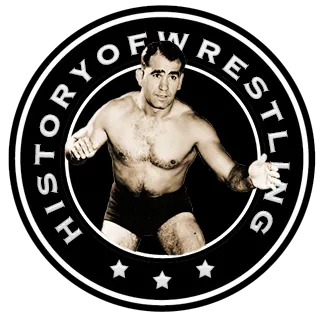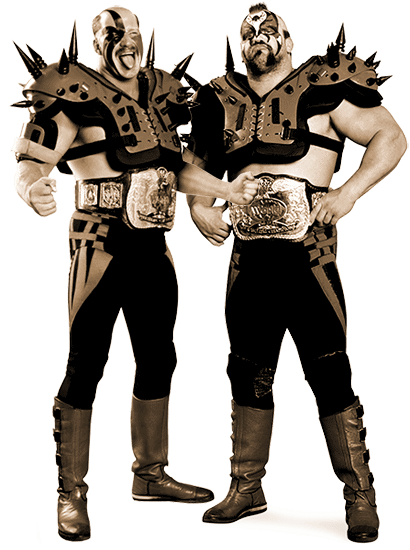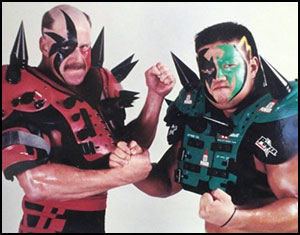by Stephen Von Slagle
While there have been countless great tag teams during the long history of professional wrestling, duos that enjoyed immense popularity and box-office success, very few rose past their singles counterparts to reach the elite level of genuine main event status. Indeed, the list is quite short. During the 1950s, the incredibly popular tandem of Antonino Rocca & Miguel Perez certainly achieved headliner status, as did Dr. Jerry Graham & Eddie Graham, the infamous Golden Grahams. Later, teams like The Fabulous Freebirds, The Rock n’ Roll Express and The Fabulous Ones each attained a level of exceptional stardom that enabled them to headline regional cards, at least for a time. However, as successful as those great tag teams may have been, none can legitimately compare to the international ticket-selling ability of the Legion of Doom, Hawk & Animal, The Road Warriors. After first bursting onto the wrestling scene early in 1983 via TBS’s World Championship Wrestling, the two gargantuan, massively muscled brawlers, clad in black ring wear, leather motorcycle gear and sporting crew cuts were, visually, quite unique, especially when compared to their contemporaries. But, when Hawk & Animal began wearing war-paint makeup not long after their debut, the infamous Road Warrior look was truly complete. Their trendsetting style and appearance would go on to influence a generation of pro wrestlers and produce numerous imitators over the years, including teams such as Demolition, The Powers of Pain, The Bladerunners and The Ascension. But, as talented and impressive as many of the Road Warrior clones may have been, none came close to having the worldwide impact as did the originals. Not since Andre the Giant had wrestlers appeared as impervious to pain or as unshakable and unbeatable as Hawk & Animal, whose legendary entrance theme, Iron Man by Black Sabbath, became synonymous with their team. As a result, the ever-growing aura of the mighty Road Warriors truly preceded the mammoth duo and, relatively speaking, they became one of the industry’s top attractions virtually overnight.
 The story of The Road Warriors begins not on a post-apocalyptic battlefield or the unforgiving streets of their adopted hometown of Chicago, but, rather, in St. Paul, Minnesota. Having received their initial training at Eddie Sharkey’s camp, Mike “Hawk” Hegstrand and Joe “Animal” Laurinaitis were working as bouncers at a rough Minneapolis bar when they met Ole Anderson, booker for TBS’s World Championship Wrestling. Anderson immediately saw potential in the two hulking bruisers and brought them into his territory. Laurinaitis had a short stint in G.C.W.’s singles ranks wrestling as The Road Warrior before being joined by Hegstrand and forming the team that would soon take the wrestling world by storm.
The story of The Road Warriors begins not on a post-apocalyptic battlefield or the unforgiving streets of their adopted hometown of Chicago, but, rather, in St. Paul, Minnesota. Having received their initial training at Eddie Sharkey’s camp, Mike “Hawk” Hegstrand and Joe “Animal” Laurinaitis were working as bouncers at a rough Minneapolis bar when they met Ole Anderson, booker for TBS’s World Championship Wrestling. Anderson immediately saw potential in the two hulking bruisers and brought them into his territory. Laurinaitis had a short stint in G.C.W.’s singles ranks wrestling as The Road Warrior before being joined by Hegstrand and forming the team that would soon take the wrestling world by storm.
 Success came quickly for the technically limited young brawlers, neither of whom had even a year’s worth of experience before being paired together. Indeed, when The Road Warriors made their first appearance in Georgia on June 11, 1983, they did so as champions, wearing the NWA National Tag Team belts after “winning” a fictitious tournament for the vacant championship. While the massive push they received from Georgia Championship Wrestling may have been a bit of a gamble considering their inexperience, it was a calculated risk that certainly paid off. Although they were completely unknown by fans of the time, they were presented in a manner that enabled them to become major attractions immediately. Upon the recommendation of G.C.W. minority owner Bill Watts, Hawk & Animal soon added war paint to their gimmick, an inspired idea that would become synonymous with their imposing look.
Success came quickly for the technically limited young brawlers, neither of whom had even a year’s worth of experience before being paired together. Indeed, when The Road Warriors made their first appearance in Georgia on June 11, 1983, they did so as champions, wearing the NWA National Tag Team belts after “winning” a fictitious tournament for the vacant championship. While the massive push they received from Georgia Championship Wrestling may have been a bit of a gamble considering their inexperience, it was a calculated risk that certainly paid off. Although they were completely unknown by fans of the time, they were presented in a manner that enabled them to become major attractions immediately. Upon the recommendation of G.C.W. minority owner Bill Watts, Hawk & Animal soon added war paint to their gimmick, an inspired idea that would become synonymous with their imposing look.
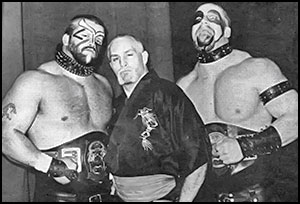 While their incredible physiques, unique appearance and fresh, new gimmick were all unquestionably big elements of the Road Warrior’s initial success, another equally important factor was their leader, former wrestler-turned-manager, “Precious” Paul Ellering. Prior to the Road Warriors exploding onto national television via TBS, Ellering (who, like the men he would go on to manage, sported an impressive physique during the prime of his in-ring career) had been a rising star in the AWA and various territories throughout the NWA until injury forced the premature end of his budding wrestling career. As the manager of Hawk and Animal (as well as the masked Spoiler, Jake “The Snake” Roberts and King Kong Bundy) Ellering, the scheming, Wall Street Journal-wielding Legion of Doom mastermind was a unique managerial figure and a key player in several of the Georgia territory’s most successful and entertaining storylines during this time period.
While their incredible physiques, unique appearance and fresh, new gimmick were all unquestionably big elements of the Road Warrior’s initial success, another equally important factor was their leader, former wrestler-turned-manager, “Precious” Paul Ellering. Prior to the Road Warriors exploding onto national television via TBS, Ellering (who, like the men he would go on to manage, sported an impressive physique during the prime of his in-ring career) had been a rising star in the AWA and various territories throughout the NWA until injury forced the premature end of his budding wrestling career. As the manager of Hawk and Animal (as well as the masked Spoiler, Jake “The Snake” Roberts and King Kong Bundy) Ellering, the scheming, Wall Street Journal-wielding Legion of Doom mastermind was a unique managerial figure and a key player in several of the Georgia territory’s most successful and entertaining storylines during this time period.
 Another aspect of the success of the trio known as the Legion of Doom that became evident early on was their interview ability, which was exceptional. Individually, each performer was able to deliver a better-than-average promo (a primary component in the success of any pro wrestler) and, collectively, the ferocious yet intelligent and, at times, maniacally humorous musclemen always left their viewing public entertained, if not a bit frightened.
Another aspect of the success of the trio known as the Legion of Doom that became evident early on was their interview ability, which was exceptional. Individually, each performer was able to deliver a better-than-average promo (a primary component in the success of any pro wrestler) and, collectively, the ferocious yet intelligent and, at times, maniacally humorous musclemen always left their viewing public entertained, if not a bit frightened.
Following their stay in Georgia, the Warriors traveled to the site of the childhood wrestling memories, Verne Gagne’s American Wrestling Association. As had been the case in Georgia, the L.O.D. made their AWA debut as villainous (but respected) heels and then, eventually, transformed into incredibly popular babyface bulldozers, a formula that proved to be quite successful. Following their win over reigning AWA World Tag Team titleholders The Crusher & Baron Von Raschke in August of 1984, the Road Warriors went on the rule the AWA tag division for more than one year as champions. During their reign as AWA World Tag Team titleholders, The Road Warriors represented their promotion in several AWA-NWA crossover ‘dream matches’ against NWA World Tag Team champions Ivan & Nikita Koloff, matches which helped draw some very large crowds for promoters Verne Gagne and Jim Crockett.
Eventually, the mighty Road Warriors were defeated for their AWA championship by the unlikely duo of “Gorgeous” Jimmy Garvin & “Mr. Electricity” Steve Regal. Garvin and Regal’s win, however, was not without controversy and it was clear to all who witnessed the match that the L.O.D. had been robbed of their World championship. Following the loss of the AWA title, Ellering and his men traveled to Jim Crockett’s NWA promotion, which, by the time the Warriors arrived in 1986, was the home of some of the best tag teams in wrestling history, all of whom were in the prime of their careers. Crockett’s NWA showcased the likes of Jim Cornette and his highly talented Midnight Express, as well as the young and exciting Rock n’ Roll Express. Meanwhile, the powerful Soviet triad of former WWWF champion Ivan Koloff, his nephew “The Russian Nightmare” Nikita Koloff and U.S.-born ‘turncoat’ Krusher Kruschev were a devastating NWA force as well. Of course, the precision and power of Arn Anderson & Tully Blanchard — The Horsemen — certainly cannot be forgotten. In fact, the over-abundance of talent in the NWA’s Tag Team division almost seemed to work against the L.O.D., though not in the way one might first think.
 The aura of power and invincibility of The Road Warriors did not wane in light of the NWA’s deeper talent base; in fact, it grew. With so many deserving, quality opponents to put the Warriors up against, NWA matchmakers were able to keep the team that virtually no one could defeat out of the NWA World Tag Team championship picture (at least in terms of them winning the titles) for more than two years. Granted, the Legion of Doom held the on-again-off-again NWA World Six Man Tag team championship for nearly twenty months between 1986-88, however, the Six Man title was (rightfully) viewed by fans as being several notches below the World Tag Team championship in terms of prestige. Still, by having the Warriors battle, say, the Horsemen in a non-title grudge match while The Midnight Express challenged The Rock n’ Roll Express (or vice versa, as the case may have been) for the Tag Team championship, fans were treated to an even better night of action with more meaningful, high-quality matches.
The aura of power and invincibility of The Road Warriors did not wane in light of the NWA’s deeper talent base; in fact, it grew. With so many deserving, quality opponents to put the Warriors up against, NWA matchmakers were able to keep the team that virtually no one could defeat out of the NWA World Tag Team championship picture (at least in terms of them winning the titles) for more than two years. Granted, the Legion of Doom held the on-again-off-again NWA World Six Man Tag team championship for nearly twenty months between 1986-88, however, the Six Man title was (rightfully) viewed by fans as being several notches below the World Tag Team championship in terms of prestige. Still, by having the Warriors battle, say, the Horsemen in a non-title grudge match while The Midnight Express challenged The Rock n’ Roll Express (or vice versa, as the case may have been) for the Tag Team championship, fans were treated to an even better night of action with more meaningful, high-quality matches.
 Meanwhile, overseas in Japan, the Warriors wore New Japan Pro Wrestling’s highly respected NWA International Tag Team championship from March of 1987 through June of 1988. As the International Tag Team champions, Hawk & Animal, despite the differences in American and Japanese work styles, dominated the talented, deep Japanese tag ranks as overwhelmingly as they had in their homeland. As top attractions for both Antonio Inoki’s New Japan Pro Wrestling and Shohei “Giant” Baba’s All Japan Pro Wrestling, Hawk & Animal were clearly among the elite U.S. competitors to regularly tour Japan and the Road Warriors quickly gained legendary status in the Land of the Rising Sun.
Meanwhile, overseas in Japan, the Warriors wore New Japan Pro Wrestling’s highly respected NWA International Tag Team championship from March of 1987 through June of 1988. As the International Tag Team champions, Hawk & Animal, despite the differences in American and Japanese work styles, dominated the talented, deep Japanese tag ranks as overwhelmingly as they had in their homeland. As top attractions for both Antonio Inoki’s New Japan Pro Wrestling and Shohei “Giant” Baba’s All Japan Pro Wrestling, Hawk & Animal were clearly among the elite U.S. competitors to regularly tour Japan and the Road Warriors quickly gained legendary status in the Land of the Rising Sun.
 Eventually, back home in the States, the Road Warriors did get their previously elusive NWA World Tag Team championship victory when, following a dramatic and unexpected heel turn, they defeated The Midnight Express on October 29, 1988. Yet, despite a vicious, bloody attack on Dusty Rhodes and a feud with the popular Midnight Express (who were, for the first time, being portrayed as babyfaces) the NWA’s fans just could not embrace the concept of booing the Road Warriors. So, they didn’t. Not surprisingly, it wasn’t long before the L.O.D. was back to facing a new collection of talented NWA heel teams such as the Samoan Swat Team (Fatu & Sumu), Doom (Ron Simmons & Butch Reed) and The Skyskrapers (Sid Vicious & Dan Spivey). However, Animal & Hawk’s run as the NWA World Tag Team champions ended just six months after it began, in the same city where they originally won the belts; New Orleans, Louisiana. On April 2, 1989, The Road Warriors were defeated by The Varsity Club (Kevin Sullivan and Mike Rotundo) for the their belts, which ended their sole reign as NWA World Tag team champions. Later, the Warriors engaged in a memorable feud with manager Paul Jones’ equally strong duo of The Warlord & The Barbarian, the very L.O.D.-ish team known as the Powers of Pain.
Eventually, back home in the States, the Road Warriors did get their previously elusive NWA World Tag Team championship victory when, following a dramatic and unexpected heel turn, they defeated The Midnight Express on October 29, 1988. Yet, despite a vicious, bloody attack on Dusty Rhodes and a feud with the popular Midnight Express (who were, for the first time, being portrayed as babyfaces) the NWA’s fans just could not embrace the concept of booing the Road Warriors. So, they didn’t. Not surprisingly, it wasn’t long before the L.O.D. was back to facing a new collection of talented NWA heel teams such as the Samoan Swat Team (Fatu & Sumu), Doom (Ron Simmons & Butch Reed) and The Skyskrapers (Sid Vicious & Dan Spivey). However, Animal & Hawk’s run as the NWA World Tag Team champions ended just six months after it began, in the same city where they originally won the belts; New Orleans, Louisiana. On April 2, 1989, The Road Warriors were defeated by The Varsity Club (Kevin Sullivan and Mike Rotundo) for the their belts, which ended their sole reign as NWA World Tag team champions. Later, the Warriors engaged in a memorable feud with manager Paul Jones’ equally strong duo of The Warlord & The Barbarian, the very L.O.D.-ish team known as the Powers of Pain.
Following their nearly five-year-long tenure in the NWA, and after remaining one of the few NWA attractions that had not been lured to the WWF, The Road Warriors (minus Paul Ellering and now known exclusively as The Legion of Doom) finally entered the World Wrestling Federation in 1990. Upon their arrival, the L.O.D. quickly settled into major feuds with the two most notable Road Warrior-inspired teams of the era; first, their former NWA rivals The Powers of Pain and, later, Demolition. Hawk & Animal also had an exciting and memorable series with The Hart Foundation. Then, on August 26, 1991, the Legion of Doom made wrestling history by defeating the Nasty Boys and capturing the WWF Tag Team title, thus becoming the only team to have won versions of the World Tag Team championship in each of North America’s “Big Three” promotions; the AWA, NWA and WWF
 Several months into their WWF tenure, the Legion of Doom was reunited with their longtime manager when Paul Ellering was brought into the promotion. After holding the WWF Tag Team championship for nearly six months, the L.O.D. finally lost the title to Money, Inc. (Ted Dibiase & Mike Rotunda) and February 7, 1992. Meanwhile, behind the scenes, Hegstrand’s ongoing personal issues began developing a rift in his relationship with Laurinaitis and the previously inseparable partners officially split following their appearance at Summerslam 1992 in London.
Several months into their WWF tenure, the Legion of Doom was reunited with their longtime manager when Paul Ellering was brought into the promotion. After holding the WWF Tag Team championship for nearly six months, the L.O.D. finally lost the title to Money, Inc. (Ted Dibiase & Mike Rotunda) and February 7, 1992. Meanwhile, behind the scenes, Hegstrand’s ongoing personal issues began developing a rift in his relationship with Laurinaitis and the previously inseparable partners officially split following their appearance at Summerslam 1992 in London.
After the legendary team parted ways, Hawk returned to Japan and also competed in Europe, where he won the Catch Wrestling Association World Heavyweight title on December 19, 1992. Meanwhile, back in the WWF, Animal formed a short-lived team with Crush (Brian Adams) that was relatively successful, although the “new” L.O.D. never came close to reaching the level of the original team. Within months of Hawk quitting the WWF, Animal left the promotion as well, taking several years off from the sport to rehabilitate a severely injured back.
With Animal out of the picture, Hawk continued focusing on his singles career, with a great deal of success. Eventually, though, he formed a new Road Warrior-inspired team called The Hell Raisers with “The Power Warrior” Kensuke Sasake. The duo (clad in L.O.D.-style war paint and ring attire) was an extremely popular team for New Japan Pro Wrestling. The Hell Raisers wore the prestigious I.W.G.P. World Tag Team title twice; their first reign began on December 14, 1992, and lasted through August 5, 1993, while their second run with the IWGP tag straps began on January 4, 1994, and ended on November 24, 1994. While working for NJPW, Hawk also began wrestling occasionally for WCW as a singles competitor, feuding primarily with WCW International Champion “Ravishing” Rick Rude. Following his stint in WCW, Hawk appeared briefly in Extreme Championship Wrestling, where he feuded with ECW World champion “The Franchise” Shane Douglas. After competing in ECW, Hawk again returned to WCW as a singles competitor, although he did form an on-again, off-again “dream team” with Sting throughout much of 1995.
Then, as WCW Executive V.P. Eric Bischoff continued his all-out offensive against the promotion’s chief competitor, Vince McMahon’s World Wrestling Federation, the long awaited reformation of The Road Warriors finally took place. The newly reunited former Tag Team champions were major components in WCW’s storylines as TNT’s recently launched WCW Monday Nitro program battled it out with the WWF’s Monday Night Raw. With opposition such as Sting & Luger, Harlem Heat and The Steiner Brothers (to name just a few) Animal & Hawk had all of the top-level competition they could hope for. Yet, after just a few months in WCW, the Warriors suddenly left the promotion, only to return to the World Wrestling Federation as The Legion of Doom soon thereafter.
Back in the WWF, the Legion of Doom picked up where they left off, chasing the coveted WWF Tag Team championship. Yet, for whatever reasons, the once invincible Legion of Doom seemed to have lost a step or two once they returned to the Federation. In an attempt to rejuvenate the their image, the L.O.D.’s look was updated and they were teamed with a new manager in the eye-catching form of ex-Bodydonnas leader, the beautiful Sunny. Yet, shortly after the debut of the “L.O.D. 2000,” Sunny suddenly dropped out of the picture and, eventually, so too did the Legion of Doom.
However, Hawk & Animal soon returned, only this time they did so with an impressive new member of the L.O.D., the young, powerful, and abrasive Puke (formerly Darren “Droz” Drozdov). Now a trio, the ameliorated Legion of Doom seemed to regain some of the edge they had previously lost and the team (which usually featured Animal teaming with either Puke or Hawk) soon became a force once again within the WWF’s tag team ranks. Nevertheless, not long after making their debut as a trio, something appeared to be quite wrong with Animal’s “brother” Hawk. He seemed to stumble through his matches, occasionally even costing his team the victory. Additionally, his unique, blistering promos began to morph into babbling, incoherent rants. Clearly, Hawk was not himself.
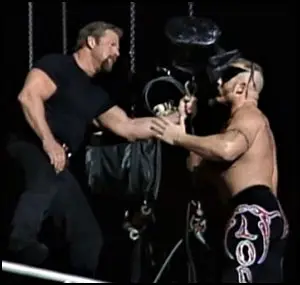 That became shockingly clear to WWF viewers during a controversial episode of Monday Night Raw when Hawk, who obviously appeared to be in an impaired condition, climbed to the top of the towering ‘Titan-Tron’ and, after accusing Animal of abandoning him, ‘fell’ from the top of the scaffolding in what appeared to be an on-air suicide attempt. It was eventually revealed to viewers that Hawk did, indeed, have a substance abuse problem but it was an envious, disingenuous Puke who had actually been his supplier. Weeks later, a clean & sober Hawk returned to WWF programming and confronted Puke before reuniting with his estranged partner Animal. The Legion of Doom, it seemed, was finally back. Yet, the reaction to the controversial storyline by fans (as well as Hawk and Animal themselves) was not positive and the angle was soon abandoned. By the Spring of 1999, the Legion of Doom had once again left the WWF, not on the best of terms with management, and the legendary duo would not return for nearly four years.
That became shockingly clear to WWF viewers during a controversial episode of Monday Night Raw when Hawk, who obviously appeared to be in an impaired condition, climbed to the top of the towering ‘Titan-Tron’ and, after accusing Animal of abandoning him, ‘fell’ from the top of the scaffolding in what appeared to be an on-air suicide attempt. It was eventually revealed to viewers that Hawk did, indeed, have a substance abuse problem but it was an envious, disingenuous Puke who had actually been his supplier. Weeks later, a clean & sober Hawk returned to WWF programming and confronted Puke before reuniting with his estranged partner Animal. The Legion of Doom, it seemed, was finally back. Yet, the reaction to the controversial storyline by fans (as well as Hawk and Animal themselves) was not positive and the angle was soon abandoned. By the Spring of 1999, the Legion of Doom had once again left the WWF, not on the best of terms with management, and the legendary duo would not return for nearly four years.
After departing the WWF, the Road Warriors made brief appearances in several different promotions, including major groups such as All Japan Pro Wrestling and TNA, as well as start-up leagues like the X.W.F., I.W.S., and various smaller independents. Away from the cameras, Mike Hegstrand was, thankfully, finally able to overcome his addictions during this time period, once and for all.
 On May 12, 2003, Animal and Hawk made an unexpected surprise appearance on Raw and took on Kane and Rob Van Dam for the World Tag Team Championship. Although they didn’t come away with the title belts, the match (and, more specifically, the return of the Legion of Doom) was very well-received by WWE fans. However, for whatever reason, they were not offered a contract and their bout against Kane & Van Dam turned out to be the final WWE appearance for the Legion of Doom.
On May 12, 2003, Animal and Hawk made an unexpected surprise appearance on Raw and took on Kane and Rob Van Dam for the World Tag Team Championship. Although they didn’t come away with the title belts, the match (and, more specifically, the return of the Legion of Doom) was very well-received by WWE fans. However, for whatever reason, they were not offered a contract and their bout against Kane & Van Dam turned out to be the final WWE appearance for the Legion of Doom.
On October 19, 2003, the world of professional wrestling was shocked and saddened by the unexpected death of Road Warrior Hawk, Mike Hegstrand. The victim of a heart attack, Hegstrand was only 46 years old when he passed away. Following the unexpected death of his longtime partner and friend, Animal took some time off before returning to WWE in 2005. Once he was back in the promotion, Animal quickly formed a new tag team with the imposing John Heidenreich and on July 24, 2005, the menacing duo defeated M-N-M (Joey Mercury & Johnny Nitro) to win the WWE Tag Team championship. During their three months as champions, they continued their feud with M-N-M and briefly added valet Christy Hemme to the package before the new L.O.D. lost the championship back to M-N-M on October 28, 2005. The team continued on until January of 2006, when Heidenreich was released by World Wrestling Entertainment. Animal was repackaged as a singles performer, using his original name and persona, The Road Warrior, until he was also let go by WWE
Several months after leaving WWE, Animal resurfaced in All Japan Pro Wrestling on September 1, 2007, and made an immediate impact on the promotion when he teamed with Hawk’s former partner in The Hell Raisers, Kensuke Sasake. Known as The Hell Warriors, Animal Warrior & Power Warrior combined to make an impressive team that helped bring credibility and excitement to AJPW, which, at the time, was struggling both creatively and financially. The Hell Warriors also competed in Mexico, for the Toryumon Mexico promotion and on May 11, 2008, they defeated Damián el Terrible and Damián 666 to capture the U.W.A. World Tag Team championship at Toryumon’s Dragon-Mania event.
 On March 1, 2011, Joe “Animal” Laurinaitis released his autobiography, The Road Warriors: Danger, Death, and the Rush of Wrestling. Co-written by William Andrew Wright, the insightful book delved deeply into the story of The Road Warriors from their beginning to the end and was received positively by fans and critics.
On March 1, 2011, Joe “Animal” Laurinaitis released his autobiography, The Road Warriors: Danger, Death, and the Rush of Wrestling. Co-written by William Andrew Wright, the insightful book delved deeply into the story of The Road Warriors from their beginning to the end and was received positively by fans and critics.
On September 9, 2020, Joe “the Road Warrior” Laurinaitis, passed away from natural causes in Osage Beach, Minnesota at the age of 60.
Hawk & Animal, the legendary Road Warriors, were voted Tag Team of the Year by the readers of Pro Wrestling Illustrated an unprecedented four different times between 1983-88. Additionally, they are members of the Wrestling Observer Newsletter’s Hall of Fame (1996), the WWE Hall of Fame (2011), the Professional Wrestling Hall of Fame & Museum (2011), the NWA Hall of Fame (2012), and the Quebec Wrestling Hall of Fame (2015).
